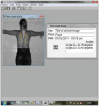ASSOCIATION BETWEEN SCAPULAR DYSKINESIA AND SHOULDER PAIN IN YOUNG ADULTS
- PMID: 28149189
- PMCID: PMC5266654
- DOI: 10.1590/1413-785220162405142225
ASSOCIATION BETWEEN SCAPULAR DYSKINESIA AND SHOULDER PAIN IN YOUNG ADULTS
Abstract
Objective: To analyze the position of the scapula and its influence on shoulder pain.
Methods: In this study, 30 sedentary young adults of both genders, aged 20-35 years were evaluated. The sample was divided into two groups with the same number of subjects, one group with shoulder pain and the other pain free. The analysis of the positioning of the scapula in six angles of shoulder abduction was taken 0º, 30º, 60º, 90º, 120º and 180º.
Results: Comparison the left and right scapular movements in males of the pain group, there was a significant difference at 30º (p = 0.018) and 120º (p = 0.04). Comparing the right and left shoulders in the pain group, there was a significant difference at 0º (p = 0.03).
Conclusion: This study concludes that changing the positioning of the scapula affects shoulder pain in sedentary young adult males at certain specific positions. Level of Evidence III, Study of non consecutive patients; without consistently applied reference ''gold'' standard.
Keywords: Dyskinesias; Scapula; Shoulder; Shoulder pain.
Conflict of interest statement
All the authors declare that there is no potential conflict of interest referring to this article.
Figures
Similar articles
-
Scapular upward rotation position is symmetrical in swimmers without current shoulder pain.Phys Ther Sport. 2018 Jan;29:9-13. doi: 10.1016/j.ptsp.2017.09.003. Epub 2017 Sep 22. Phys Ther Sport. 2018. PMID: 29156219
-
Scapular behavior in shoulder impingement syndrome.Arch Phys Med Rehabil. 2002 Jan;83(1):60-9. doi: 10.1053/apmr.2002.27471. Arch Phys Med Rehabil. 2002. PMID: 11782834
-
Subacromial anaesthetics increase asymmetry of scapular kinematics in patients with subacromial pain syndrome.Man Ther. 2016 Dec;26:31-37. doi: 10.1016/j.math.2016.07.002. Epub 2016 Jul 17. Man Ther. 2016. PMID: 27469585
-
Clinical assessment of the scapula: a review of the literature.Br J Sports Med. 2014 Jun;48(11):883-90. doi: 10.1136/bjsports-2012-091059. Epub 2012 Jul 21. Br J Sports Med. 2014. PMID: 22821720 Review.
-
Scapular positioning and movement in unimpaired shoulders, shoulder impingement syndrome, and glenohumeral instability.Scand J Med Sci Sports. 2011 Jun;21(3):352-8. doi: 10.1111/j.1600-0838.2010.01274.x. Epub 2011 Mar 8. Scand J Med Sci Sports. 2011. PMID: 21385219 Review.
Cited by
-
Scapular Dyskinesis: From Basic Science to Ultimate Treatment.Int J Environ Res Public Health. 2020 Apr 24;17(8):2974. doi: 10.3390/ijerph17082974. Int J Environ Res Public Health. 2020. PMID: 32344746 Free PMC article. Review.
-
Correlation of scapular Dyskinesia and hand grip strength in students with smartphone addiction pursuing a bachelor's degree in healthcare profession education.Shoulder Elbow. 2025 Jan 8:17585732241309088. doi: 10.1177/17585732241309088. Online ahead of print. Shoulder Elbow. 2025. PMID: 39790906 Free PMC article.
References
-
- Garzedin DDS, Matos MAA, DCH, Barros RM, Guimarães A. Intensidade da dor em pacientes com síndrome do ombro doloroso. Acta Ortop Bras. 2008;16(3):165–167.
-
- Babyar SR. Excessive scapular motion in individuals recovering from painful and stiff shoulders causes and treatment strategies. Phys Ther. 1996;76(3):226–238. - PubMed
-
- Ejnisman B. Lesões músculo esqueléticas no ombro do atleta mecanismo de lesão diagnóstico e retorno a pratica esportiva. Rev Bras Ortop. 2001;36(10):389–393.
-
- Myers JB, Laudner KG, Pasquale MR, Bradley JP, Lephart SM. Scapular position and orientation in throwing athletes. Am J Sports Med. 2005;33(2):263–271. - PubMed
-
- Andrews JR, Harrelson GL, Wilk KE. Reabilitação física das lesões desportivas. Rio de Janeiro: Guanabara Koogan; 2000.
LinkOut - more resources
Full Text Sources
Other Literature Sources


